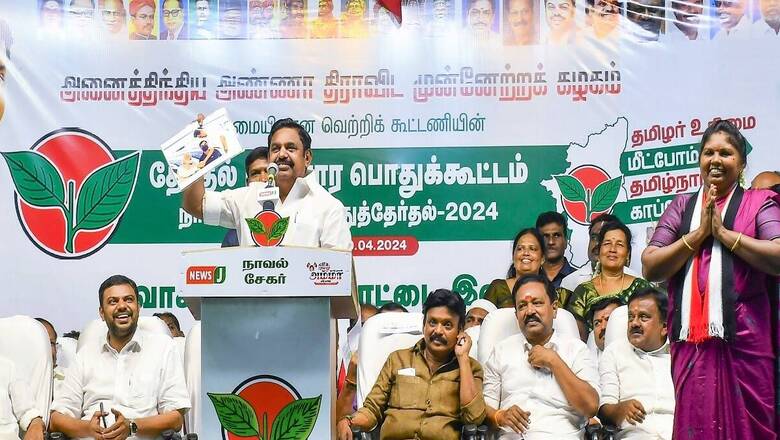
views
The All India Anna Dravida Munnetra Kazhagam (AIADMK) is facing an existential crisis in Tamil Nadu. Founded by M.G. Ramachandran in 1972 and ably led by J. Jayalalithaa, the party split into three factions after her death in 2016. The party also lost all 39 Lok Sabha seats in the 2024 polls. Edappadi K Palaniswami, who ruled Tamil Nadu for four years after Jayalalithaa, interestingly managed to retain the majority of AIADMK cadres, elected representatives, and, in particular, the famous two-leaves poll symbol.
K Palaniswami recently convened a meeting in Chennai with party cadres from each district to discuss the reasons behind the AIADMK’s electoral debacle. Notably, several key figures who broke away from Palaniswami after the 2021 Tamil Nadu Assembly elections are now seeking a merger of the splinter groups. These figures include O. Panneerselvam, a prominent leader of the Thevar caste in Tamil Nadu; T.T.V. Dhinakaran, who heads the Amma Makkal Munnetra Kazhagam; and V.K. Sasikala, also from the Thevar caste. K Palaniswami belongs to the powerful Gounder caste.
The 2024 Lok Sabha elections dealt a major setback to the Palaniswami faction, with many of its candidates losing their deposits. The party has now lost ten consecutive elections—both civic and parliamentary—to the ruling Dravida Munnetra Kazhagam (DMK) led by MK Stalin. The AIADMK in Tamil Nadu has been reduced to Gounder and Thevar outfits.
Cadre wants a merger
The AIADMK is losing ground in Tamil Nadu. The political space it once occupied is being claimed by either the Bharatiya Janata Party (BJP) or the DMK, as evidenced by the voting patterns in the 2024 Lok Sabha elections. Concerned by this trend, loyalists of MGR and Jayalalithaa recently formed a “peace committee” to explore a merger of all AIADMK factions. The party cadre, yearning for strong leadership against their arch-rival DMK, are pushing for unity. However, all four factions have, at various points, expressed support for Dravidian culture and MK Stalin. The eight or so Dravidian parties that have emerged in Tamil Nadu since 1967 appear united in their opposition to Hindutva and the BJP’s rise.
It was MGR and Jayalalithaa who first introduced elements of soft Hindutva ideology into Tamil Nadu politics. This explains Jayalalithaa’s strong advocacy for the Ram Mandir and the abrogation of Article 370 in Kashmir. This distinct political approach is now proving somewhat advantageous to K Palaniswami and O Panneerselvam, the prominent leaders of the powerful Gounder and Thevar castes, respectively, as it allows them to differentiate themselves from the prevailing Dravidian ideology.
However, the AIADMK’s estimated three crore members primarily want to defeat MK Stalin and the DMK through a more traditionally aggressive political strategy reminiscent of Jayalalithaa’s tactics. Growing increasingly disillusioned with the party’s internal caste politics, a significant portion of the AIADMK cadre is choosing to leave. This exodus, evident after the 2021 state elections, the 2024 Lok Sabha elections, and the recent Vikravandi Assembly by-election in July 2024, has plunged the AIADMK into an existential crisis. While the Gounder faction has distanced itself from the BJP, the Thevar group remains aligned with them, further highlighting the ideological and caste-based fissures within the AIADMK. These divisions have led to accusations of caste dominance from both sides, exacerbating the party’s internal struggles.
2026 Assembly Polls looming large
With Assembly elections approaching in 2026, the AIADMK faces a critical year ahead. If the peace committee established by MGR loyalists fails to reunite the party, the AIADMK risks further fragmentation. There is a growing possibility of another split, the fifth from the K Palaniswami camp, with some members expressing a desire to align with smaller parties like the SDPI or Seeman’s Naam Tamizhar Katchi (NTK), another proponent of Dravidian ideology. Seeman is a staunch supporter of the Eelam Tamil cause. The question remains: will Palaniswami find himself compelled to join forces with the NTK or Seeman to salvage his political prospects?
The future of AIADMK
From a purely political standpoint, and without bias, the future of AIADMK appears very bleak. Unless the splinter groups implement a course correction, AIADMK is headed for yet another split – this time, openly favouring either the DMK or the BJP.
Is there a New Delhi hand in all of this?
The answer is obviously yes. This strategy was proposed by Union Home Minister Amit Shah shortly after Jayalalithaa’s demise. However, K Palaniswami remained adamant. Had the BJP proposal been accepted before the 2024 Lok Sabha polls, the DMK would not have swept the state with 40/40 seats.
2026 is therefore crucial
If K Palaniswami remains adamant with his 66 MLAs and 6 Rajya Sabha MPs, 2026 will be a cakewalk for MK Stalin’s DMK. This will leave the remaining eight smaller parties, such as Dr Anbumani Ramadoss’ PMK, GK Vasan’s Tamil Maanila Congress, and Seeman’s NTK, in further disarray.
The author is a Veteran Journalist, based in New Delhi and observer of Southern political parties, in particular Tamil Nadu Dravidian parties.


















Comments
0 comment